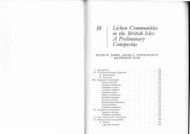You also want an ePaper? Increase the reach of your titles
YUMPU automatically turns print PDFs into web optimized ePapers that Google loves.
C. rufescens sits on high relief limestone and<br />
calcareous silicate rocks. C. lachneum and C.<br />
waltheri which are not recorded from the region,<br />
occurring in the neighboring Allgäu arctic-<br />
alpine, establish themselves <strong>of</strong>ten in soil filled<br />
rock fissures. The soil dwellers are as a result <strong>of</strong><br />
amelioration and enclosure <strong>of</strong> land (e.g. vineyard<br />
allocation) in regression.<br />
C. cinereum, C. daedalum, C. lachneum and<br />
C. waltheri are arctic/boreal-alpine species,<br />
which penetrate up into the mountains <strong>of</strong> south<br />
Europe; C. cinereum and C. daedalum existing,<br />
thus in the region, as relict occurrences in<br />
relatively nearer sea level. The area <strong>of</strong> C.<br />
psoromoides, C. pilosellum and tremniacense<br />
reaches over central- and south Europe; here we<br />
have also C. rufescens, C. squamulosum and the<br />
more rare C. michelii whose high point, occurs<br />
however even in north Europe.<br />
Genus Characteristics and Determination<br />
Thallus squamulose, commonly light to dark<br />
brown, red-brown, sometimes thickly white<br />
pruinose, stratified construction, upper side with<br />
paraplectenchymatous cortex, <strong>of</strong> ± anticlinal<br />
hyphae with rounded-angular to somewhat<br />
stretched cells, under side without or with weakly<br />
to clearly set<strong>of</strong>f paraplectenchymatous cortex,<br />
attached to the substrate with colorless to brown<br />
“rhizo-hyphae.” Photobionts: coccoid green<br />
algae. Per. sunken or, when between the<br />
squamules, projecting, with black apex. Exc.<br />
dark in the region <strong>of</strong> the apex, otherwise light to<br />
dark, with or without involucrellum. Hym. I+<br />
yellow-orange to reddish, rarely bluish-green,<br />
K/I+ blue. Paraphyses lacking in ripe per.<br />
Periphyses predominantly simple. Asci thin<br />
walled, clavate to elongate cylindric, without<br />
tholus, wall I-, exterior with thin amyloid gelatin<br />
layer. Pycnosp. short cylindric to cylindric or<br />
elongate ellipsoidal. Sp. 1-celled, ellipsoidal.<br />
Ch-.<br />
1 Per. sitting between the thallus squamules, not<br />
sunken, with carbonaceous invol. Squamules ±<br />
crustose coalescing, very small, -1(1.5) mm, thin<br />
(mostly 100-200 µm thick) 2<br />
1* Per. sunken into the thallus squamules, without<br />
invol . 3<br />
2 Thallus squamules with blackish paraplectenchymatous<br />
lower cortex. Exc. brown to blackbrown,<br />
surrounded by a ring-like carbonaceous<br />
involucre. Sp. elongate egg form to almost<br />
clavate, 17-21 x 8-10 µm. Rhizoid hyphae dark.<br />
In alpine sites C. waltheri<br />
2* Thallus squamules without lower cortex and<br />
medulla. Exc. brown to black-brown, surrounded<br />
by a carbonaceous involucre only in the upper<br />
part. Sp. ellipsoidal, 13-17(18) x 6-7 µm.<br />
Rhizoid hyphae colorless. In lower sites<br />
C. tremniacense<br />
3 Squamules entirely white pruinose, but margins<br />
<strong>of</strong>ten dark bordered, finely crenate to deeply<br />
crenate lobed,, usually coalescing, ± compressed,<br />
1-2(3) mm. Thallus with definite dark prothallus.<br />
Lower cortex blackish, paraplectenchymatous.<br />
Sp. 17-23 x 6.5-8.5 µm C. cinereum<br />
3* Squamules possibly pruinose in places . 4<br />
4 Rhizoid hyphae dark, producing a thick dark<br />
prothallus. Asci clavate, sp. ± two rows. Upper<br />
cortex thin (30 µm) 5<br />
4* Rhizoid hyphae light. Asci cylindric, sp. single<br />
series 7<br />
5 Squamules finely crenate to deeply crenate lobed,<br />
usually whitish pruinose, <strong>of</strong>ten dark bordered,<br />
usually coalescing, ± compressed. Lower cortex<br />
blackish, paraplectenchy-matous. Sp. 17-23 x<br />
6.5-8.5 µm C. cinereum<br />
5* Squamules not deeply crenate, not dark bordered,<br />
to foliose lobed, approaching ± effigurate thallus<br />
(with somewhat elongated marginal lobes),<br />
without lower cortex. Very rare species . 6<br />
6 Asci 55-65 x 13-15 µm. Sp. ellipsoidal to almost<br />
fusiform, on the average under 17 µm long (13-<br />
17 x 5.5-7 µm, sometimes with apparent two part<br />
content. Squamules usually light brown to gray<br />
or gray greenish. Lobe ends <strong>of</strong>ten flecked gray to<br />
violet gray pruinose<br />
C. psoromoides<br />
6* Asci 75-85 x 17-20 µm. Sp. elongate egg form to<br />
clavate, on the average over 17 µm (17-22 x 6-8<br />
µm), content not two-part. Marginal lobes<br />
broadly rounded, thick, nonpruinose, <strong>of</strong>ten<br />
somewhat indented. Thallus sometimes finely<br />
diffusely pruinose on the interior thallus parts<br />
(not flecked) C. daedalum<br />
7 Per. wall dark, 20 µm thick below. Sp. 11-15 x<br />
5-6 µm. Squamules 1-4 mm large, thin, -250 µm,<br />
closely attached, light to dark brown, dull,<br />
undersides blackish . C. michelii<br />
7* Per. wall colorless, over 20 µm thick 8<br />
8 Squamules covered with very fine colorless hairs<br />
at the margin . C. pilosellum (12)<br />
8* Squamules not hairy at the margin . 9<br />
9 Thallus attached directly to the rock, robust,<br />
leathery, brown to dark brown or red-brown, dull<br />
or mostly shiny, usually wavy curved.<br />
Squamules 6-10 x 3-5 mm in size, 350-600 µm<br />
thick, margins commonly somewhat raised. Sp.<br />
15-20 x 7.5-9 µm, <strong>of</strong>ten empty and deformed.<br />
Pycn. sessile on the margin . C. rufescens<br />
9* Thallus on soil or on soil encrusted rock 10<br />
143





